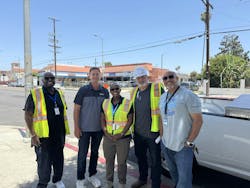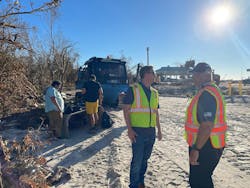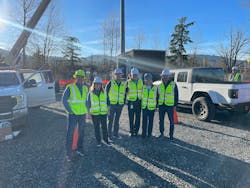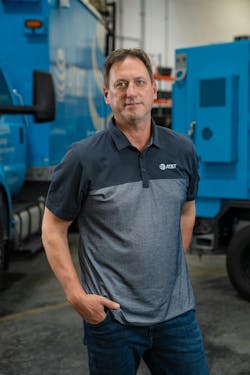Executive Insights with Robert Walters, SVP Network Planning, Construction & Engineering, AT&T
Key Highlights
- Fiber Expansion Milestone: In June 2025, AT&T passed 30 million fiber locations—achieved ahead of schedule.
- 2030 Fiber Roadmap: AT&T aims to expand its fiber footprint to pass more than 60 million locations by the end of 2030.
- Artificial Intelligence: Through AI-enabled integrated network planning and forecasting, AT&T has significantly improved the accuracy and efficiency of deploying fiber and 5G networks.
In an industry racing toward 5G, fiber expansion, and next-gen infrastructure, few people have a clearer view of the road ahead than Robert Walters, Senior Vice President of Network Planning, Construction & Engineering at AT&T. With decades of experience and a front-row seat to one of the largest networks in the world, Walters empowers teams to utilize AI, ML and critical soft-skills to design and build the future of connectivity. This Q&A with Robert is an insider’s view of what it takes to keep AT&T’s network positioned for what's next.
Topic: Fiber Kudos!
ISE: In June, your team reached a significant milestone: AT&T passed 30 million fiber locations, achieved ahead of schedule. In a LinkedIn post, you shared, “This is a testament to our hard work and operational excellence.” What are the top three improved processes your team has used to meet this milestone?
Robert Walters: Reaching the milestone of passing 30 million fiber locations ahead of schedule is a proud achievement that reflects our commitment to innovation and operational excellence.
Three key process improvements have been instrumental in this success:
First, we have significantly enhanced our tooling and technology stack throughout the fiber build journey. From planning and design automation to capturing fiber test results, we continuously seek to achieve greater efficiencies through mechanization.
Second, selecting the right materials is crucial for achieving the best results. Our supply partners are industry leaders, providing everything from custom connectorized fiber cables and terminals to appropriately sized handholes. Each component must integrate seamlessly and efficiently to deliver the highest quality service to our customers.
Additionally, collaborating with municipalities is essential to our plan. A streamlined permitting process is crucial; without it, the fiber build cannot proceed.
Finally, our success speaks to the hard work and dedication of our workforce. AT&T is committed to providing a safe working environment and to delivering products and services in a safe, environmentally responsible and sustainable manner.
We allow select cell sites to enter a low-power sleep mode during periods of low demand to conserve energy. Cell site sleeping is implemented throughout our U.S. mobility network, resulting in energy savings. By utilizing machine learning and advanced analytics, we are enhancing cell site efficiency.
Topic: 2030 Fiber Roadmap
ISE: Looking ahead, AT&T aims to expand its fiber footprint to reach approximately 60 million locations passed by the end of 2030. What technologies, tools and techniques will your team need from vendor partners to help you achieve this goal?
Walters: As we continue to expand our fiber footprint to pass more than 60 million locations by the end of 2030, we will continue to utilize automation and AI functionality within our design and construction tooling stack. We will continue to identify innovative alternatives in partnership with various suppliers. We constantly explore new innovative ways to build fiber such as micro-trenching and utilizing new technologies that allow for primary flexibility points with splices to be stored in handholes instead of cabinets. We work closely with our vendors to help ensure that our workforce is highly skilled and trained in the latest technologies and innovations.
Topic: Paying the Fiber-Learning Forward
ISE: What lessons has your team learned about streamlining make-ready processes, ROW access, and municipal collaboration to accelerate fiber deployments?
Walters: Our team has learned several valuable lessons that have been pivotal in accelerating fiber deployments.
Initiating early communication with municipalities and utility stakeholders is critical. By addressing concerns proactively, we can secure ROW permits more efficiently, reducing delays caused by last-minute approvals.
Creating standardized templates and checklists has significantly reduced administrative overhead. This consistency helps all parties clearly understand expectations, which in turn speeds up the review and approval process.
Also, utilizing digital platforms for real-time tracking and sharing of project status has enhanced transparency and collaboration. This visibility helps resolve issues quickly, coordinate inspections, and align schedules, which minimizes downtime and accelerates deployment timelines.
Close collaboration between teams ensures that potential hurdles are identified and addressed early. This integrated approach helps streamline workflows and fosters a unified strategy toward overcoming regulatory and logistical challenges.
We believe our customers deserve the best, so we’re always setting very high expectations for ourselves.
Topic: Partner Collaboration & Vendor Management
ISE: Please share three best practices your team uses to manage vendor and contractor partners, ensuring high standards, safety compliance, and efficient builds.
Walters: In our wireless space, to ensure high standards, safety compliance, and efficient builds with our vendor and contractor partners, our team employs several best practices:
- High Standards: We utilize drone capture and build modeling to verify that construction components meet specific tolerances. Additionally, the quality review process enables us to review completed work remotely, increasing oversight and overall network quality. This also lays the groundwork for AI-assisted quality assessments in the future.
- Safety Compliance: AT&T is a leader in the industry, requiring National Wireless Safety Association certification for crews climbing our towers.
- Efficient Builds: Our planning and engineering teams bundle as many construction tasks as possible during a single mobilization to ensure efficient resource utilization.
For our wireline builds, we utilize multiple approaches to ensure our suppliers are delivering at a high level, which helps drive down cost related to rework and helps deliver better customer service. In recent years, AT&T has implemented a virtual inspection process, where suppliers take pictures of certain completed work activities facilitating a virtual review by AT&T, which increases the number of locations reviewed and drives a better overall quality of the fiber network. Additionally, this is positioning the company to eventually utilize AI technology in reviewing the quality of the workmanship captured in the pictures.
AT&T has structured its contracts to include Key Performance Indicators (KPIs) to measure success factors for the work being performed by the suppliers, establish clear expectations for the suppliers on what is expected, and allows for monitoring of the results.
Topic: Network Sustainability
ISE: How is sustainability being integrated into AT&T’s construction practices, material selection and long-term network design?
Walters: The integration of sustainable practices into our operations drives efficiency and minimizes negative impacts, ultimately leading to a more competitive and resilient business.
Each year, we implement many innovative energy-efficiency projects across our network and operations, reducing electricity consumption, costs and emissions. For example, by transitioning our network from copper DSL to fiber in a particular neighborhood, we provide a faster network for our customers while reducing our energy consumption in that neighborhood by approximately 70%.
We allow select cell sites to enter a “sleep mode” during periods of low demand to conserve energy. Cell site sleeping is implemented throughout our U.S. mobility network, resulting in energy savings. Utilizing machine learning and advanced analytics, we quickly pinpoint inefficient cell sites with excessive energy use and dispatch repair teams to enhance their efficiency. Additionally, we collaborate with engineering teams to identify and retire older, less efficient network equipment where we can.
We also utilize our AT&T Geo Modeler, an AT&T-patented, AI-powered geospatial engine that creates a near-real-time, nationwide digital twin of our wireless network. It enables improved modeling of signal strength, interference, and coverage across diverse terrains.
Topic: AI Buzz Versus Realities
ISE: Share two successes your Network Operations team has realized using AI to support performance management, forecasting and optimizing resource utilization.
Walters: Our team has achieved remarkable successes by using AI to enhance performance management, forecasting, and resource optimization. Through AI-enabled integrated network planning and forecasting, we have significantly improved the accuracy and efficiency of deploying fiber and 5G networks. By analyzing vast datasets with advanced machine learning models, the team can predict demand patterns and optimize resource allocation, ensuring that network expansions are both timely and cost-effective. This proactive forecasting reduces over-provisioning and minimizes delays, ultimately enhancing service reliability for our customers.
We have achieved a 30% improvement in energy efficiency by utilizing generative AI models to optimize cell site operations, particularly through intelligent “sleeping” modes during periods of low usage. This AI-driven optimization reduces unnecessary power consumption without compromising network performance, leading to substantial cost savings and supporting AT&T’s commitment to sustainability.
We also have designed and built our AT&T Geo Modeler, which is an AT&T-patented, AI-powered geospatial engine that creates a near-real-time, nationwide digital twin of our wireless network. It enables improved modeling of signal strength, interference, and coverage across diverse terrains.
Plus, our patented Network Foundation Model (NFM) is a deep learning-powered platform that applies generative AI to unify and interpret complex network data. It combines KPIs, configurations, logs, alarms, and other inputs to provide a comprehensive and intelligent view of the network. This supports our vision of building an autonomous and predictive network.
Topic: Powering the Future
ISE: Technological innovations in power and energy storage solutions allow operators to improve network resilience. However, unforeseen circumstances often challenge the best plans. Describe the nuts and bolts behind AT&T’s network strategy that address the reality of a fallible power grid.
Walters: Maintaining network and operational continuity is essential for the millions who depend on our connectivity. Network resilience is a cornerstone of our commitment to customers and a key element of our approach to managing environmental impacts.
Our strategy includes:
- Infrastructure Investment: AT&T invests heavily in advanced technologies such as 5G, fiber optic cables and high-capacity data centers to create a strong and resilient network.
- Redundancy and Resilience: The network is designed with built-in redundancies to minimize downtime and service disruptions. This includes backup systems and multiple pathways for data transmission. When unexpected outages happen, we strive to restore service promptly.
- Risk Management: AT&T uses advanced data to forecast and help mitigate the impact of weather-related risks on its network. This includes flood vulnerability analyses and hardening solutions.
- Advanced Monitoring Tools: AT&T utilizes the AT&T Weather Operations Center, our Network Disaster Recovery (NDR) Program and established disaster response procedures to monitor and respond to weather-related events that could impact our infrastructure.
- Disaster Recovery and Preparedness: Comprehensive disaster recovery plans help ensure rapid restoration of service during emergencies. This includes mobile cell sites and other rapid deployment solutions to support affected areas. With more than 750 pieces of specialized response equipment that traverse land, sea, and air, AT&T has one of the largest disaster recovery programs in the world. Supporting First Responders: FirstNet®, built with AT&T, is the only nationwide, high-speed broadband communications platform dedicated to and purpose-built for America’s first responders and the public safety community. We built, and maintain, the network in public-private partnership with the First Responder Network Authority (FirstNet Authority).
Topic: Results
ISE: Share one story about HOW your team crushed an objective this year.
Walters: This year, our team truly crushed a monumental objective by passing 30 million fiber-eligible locations, six months ahead of our publicly announced plan. This achievement was no easy task; it demanded overcoming complex technical hurdles, navigating diverse regulatory landscapes, and executing flawlessly across countless projects and teams. This milestone is more than just a number—it’s a powerful testament to our team’s relentless passion and precision, powering communities and businesses with the fast, reliable connectivity they deserve. This sets the stage for our journey ahead to pass approximately 60 million fiber locations by the end of 2030. Together, we are not just building infrastructure; we are crafting the digital highways of the future. Our team’s achievements this year exemplify the heart and soul behind that mission.
Topic: Company Culture
ISE: Culture affects nearly every aspect of a company, and both employees and leaders experience it daily. However, bridging the divide between executive leadership and the general workforce can sometimes be tough. Share strategies you use to nurture your team’s culture.
Walters: It starts with the customer…period. When we keep the customer top of mind, everyone is working toward the same goal. We make sure each person understands how their role supports the company’s strategy and takes a genuine interest in their professional and personal goals. This drives motivation and belonging. The leadership team also promotes a culture of internal collaboration and healthy external competition, always focused on safely delivering value to our customers.
Topic: Significant Learning
ISE: What is the most important thing you’ve learned in the last year?
Walters: Everything starts on the frontline. Empowering our local leaders is the key to safely delivering what our local markets need, and we have tremendous local leadership teams that put the customer at the center of what we do day in and day out.
Topic: Constant Growth
ISE: What soft skills and leadership strategies are essential for your team members to succeed in this ever-evolving industry?
Walters: Curiosity, empathy, and a commitment to continuous improvement are critical soft skills. Leadership strategies that emphasize nurturing relationships, setting challenging milestones, and fostering a team mindset over individual competition are essential. Encouraging team members to focus on daily incremental progress helps build momentum that leads to lasting success.
Topic: Leadership Style
ISE: Share one word that encapsulates your leadership style. Share one word that describes you when you’re not working.
Walters: Leadership style: Passionate. When not working: Sleeping.
Topic: Balance
ISE: What are your thoughts about work/life balance?
Walters: “Balance” has shifted to integration mainly due to the fast evolution of connectivity technology. Use resources available to you and take advantage of AI. AI can help summarize what you’ve spent a lot of time on, and you just need to refine instead of starting from scratch.
Focus on clear goals, check-in points and time management. You should also have a maniacal focus on the mission, organizational skills, as well as prioritization.
Robert Walters leads a team of over 15,000 professionals who design, build, and operate AT&T's converged (Fiber and 5G) networks with collaborative responsibility for AT&T's annual multi-billion-dollar network capital investment strategy inclusive of spectrum, fiber and 5G expansion investments. The team is also responsible for life cycle managing the third-party access, satellite, towers, and roaming relationships. Robert also leads the fixed broadband (fiber) build program. For more information, visit www.att.com.
About the Author
Sharon Vollman
Content Ambassador for ISE EXPO
Sharon Vollman is the Content Ambassador for ISE EXPO. She is passionate about collaborating with thought leaders, SMEs and hard-working doers who design, plan and deploy ultra-reliable broadband networks. Vollman is committed to creating a variety of educational offerings for ISE EXPO attendees that inspire them to connect every U.S. citizen with the broadband networks we all want for our children and grandchildren.
Vollman has created educational partnerships with Broadband Service Providers including AT&T, Verizon, Lumen, Frontier Communications and others. She has covered the telecom industry since 1996.





